Abstract
Indoor risk factors for physician-diagnosed asthma and wheezing in the past 12 months without previous asthma diagnosis were assessed in a survey of parents of 5-9-year-old Seattle primary school students. Among the 925 respondents, 106 (11%) reported a physician diagnosis of asthma, 66 (7%) had wheezing without diagnosis, and 753 (82%) were asymptomatic. After adjusting for age, sex, gender, ethnicity, medical history, socioeconomic status (SES) and parental asthma status, an increased risk of physician diagnosis of asthma was associated with household water damage, the presence of one or more household tobacco smokers, and at least occasional environmental tobacco smoke (ETS) exposure. Similarly, an increased risk of wheezing in the past 12 months among children without diagnosed asthma was associated with household water damage, presence of one or more household tobacco smokers, and occasional or more frequent ETS exposure. No increased risk of either condition was associated with gas, wood, or kerosene stove use, household mold, basement water, or wall/window dampness. Similarities in the indoor risk factors patterns between diagnosed asthma and wheezing without diagnosis suggested a similar etiology of these two conditions. The slightly higher association between ETS and asthma may indicate that parents of diagnosed asthmatics were more conscious of ETS, and were more likely to prohibit household smoking by resident smokers. Future research is needed to quantify which aspects of household water damage are related to respiratory illness.
Full text
PDF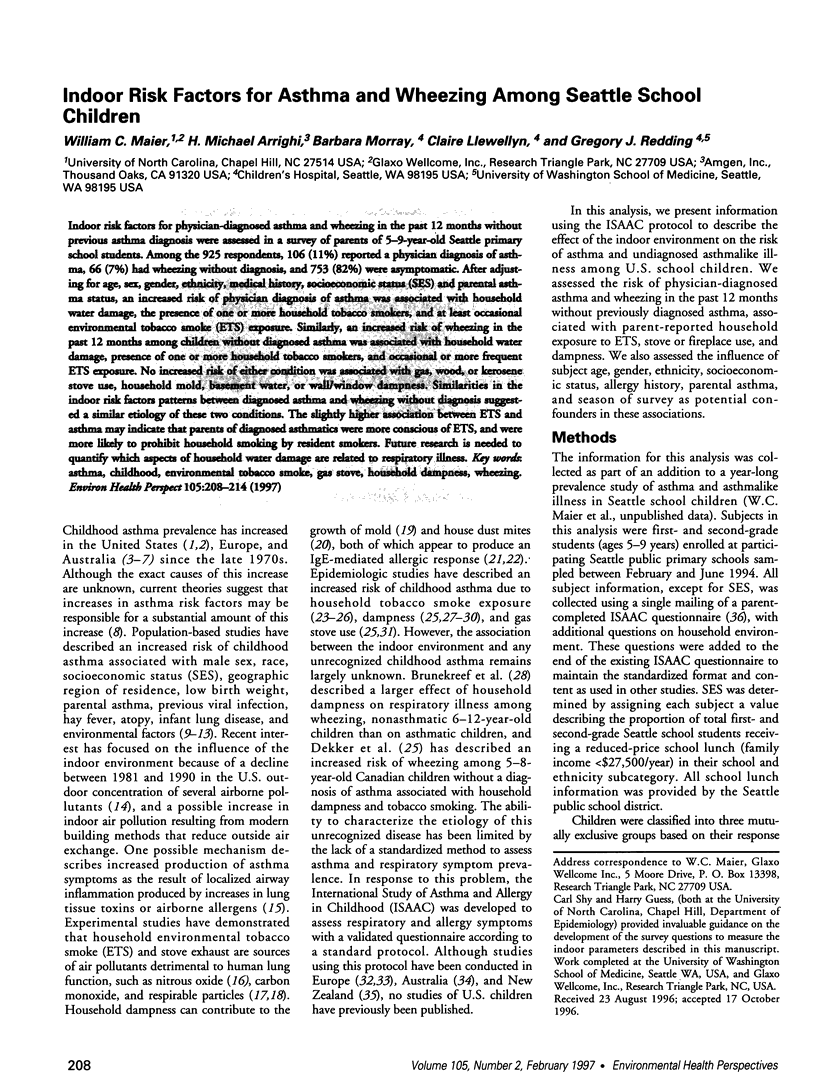

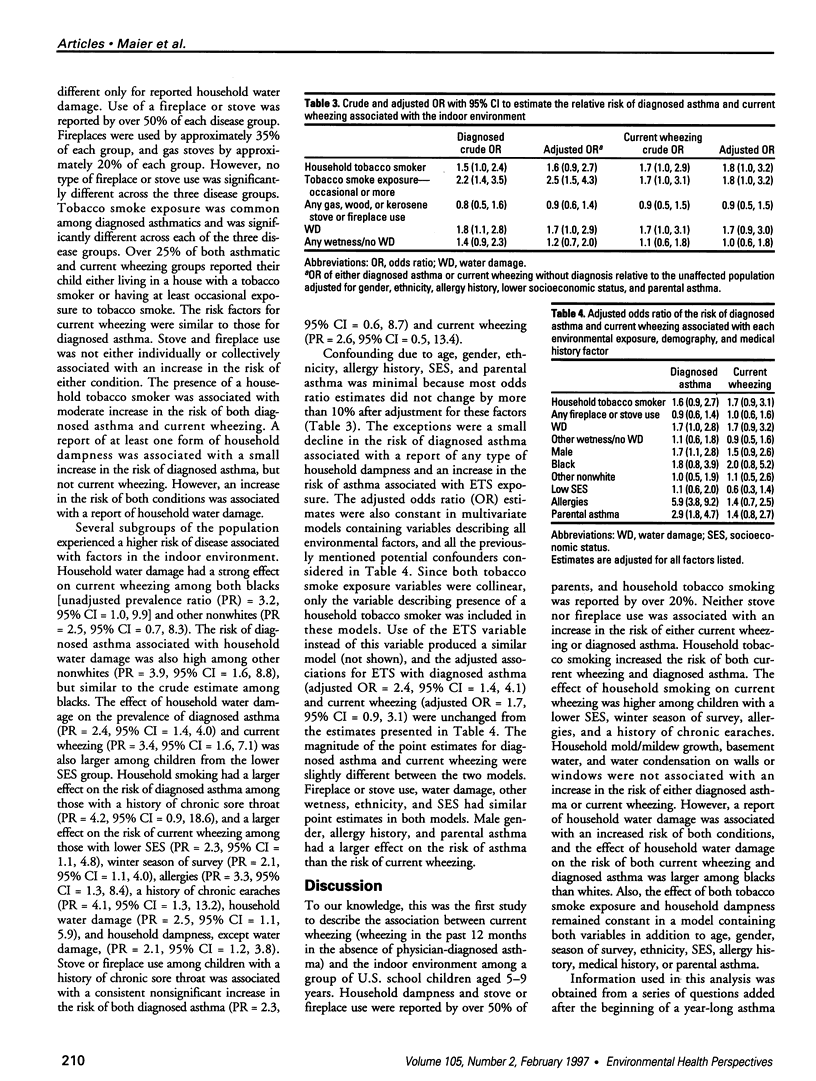
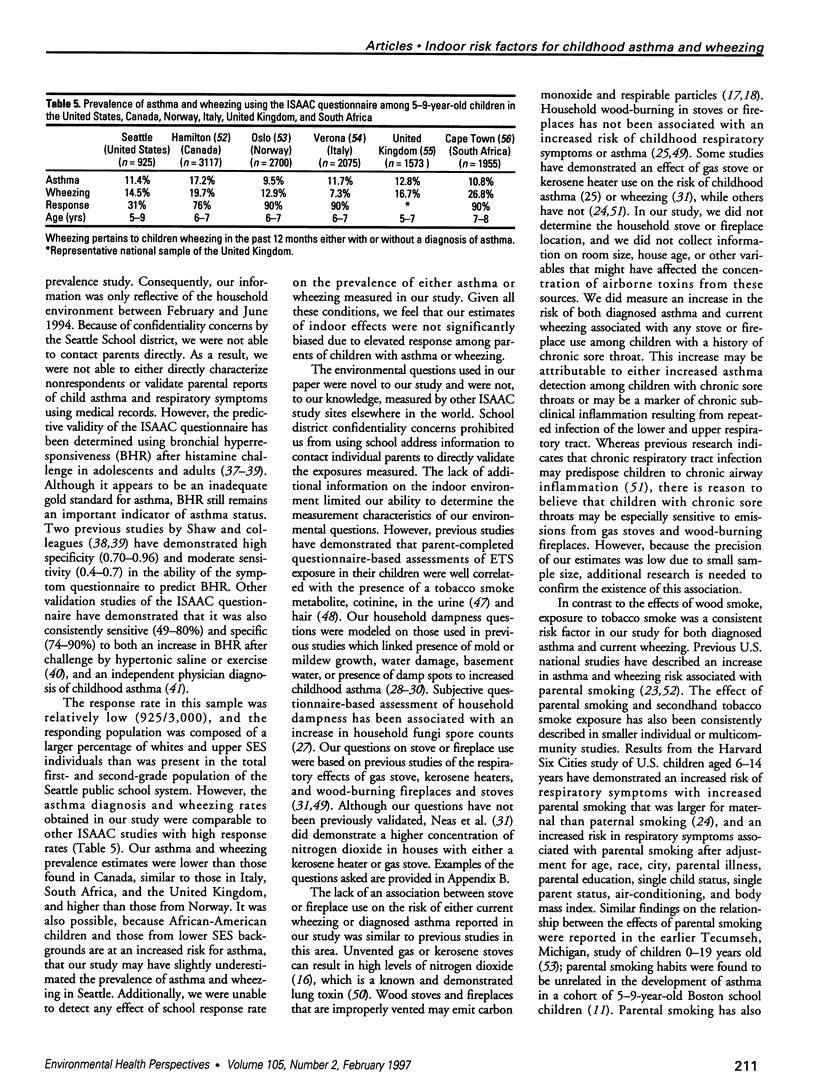
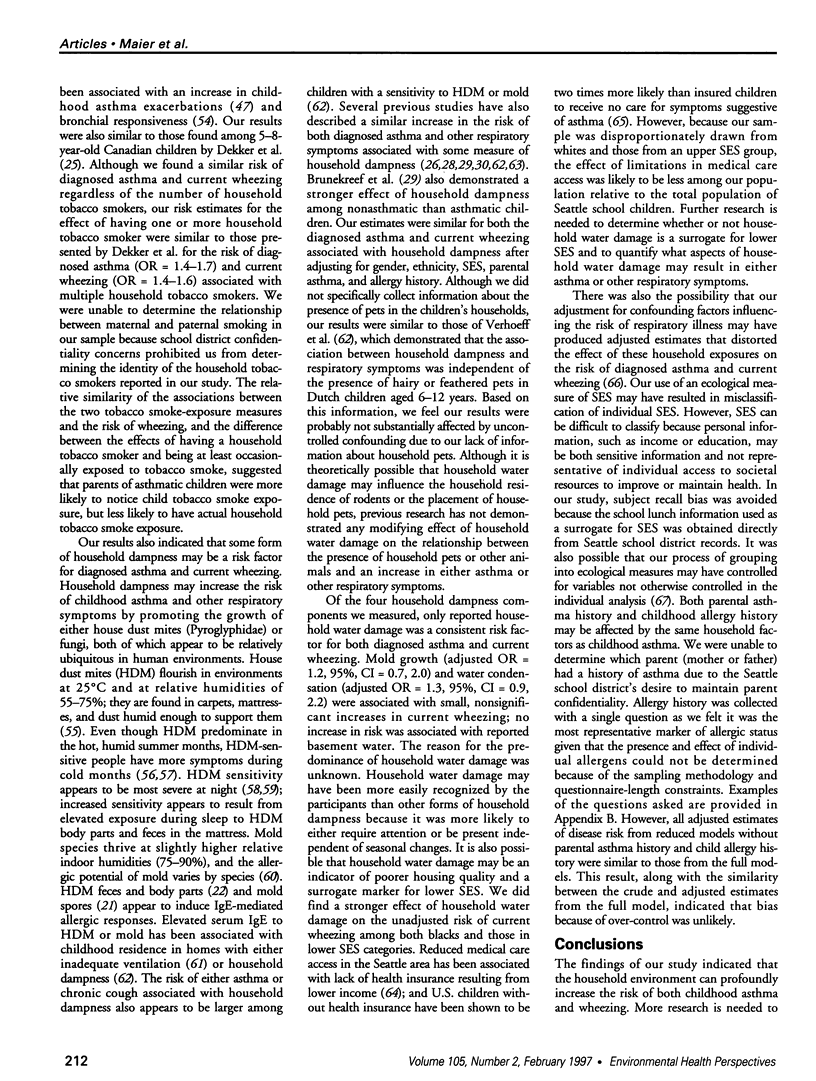
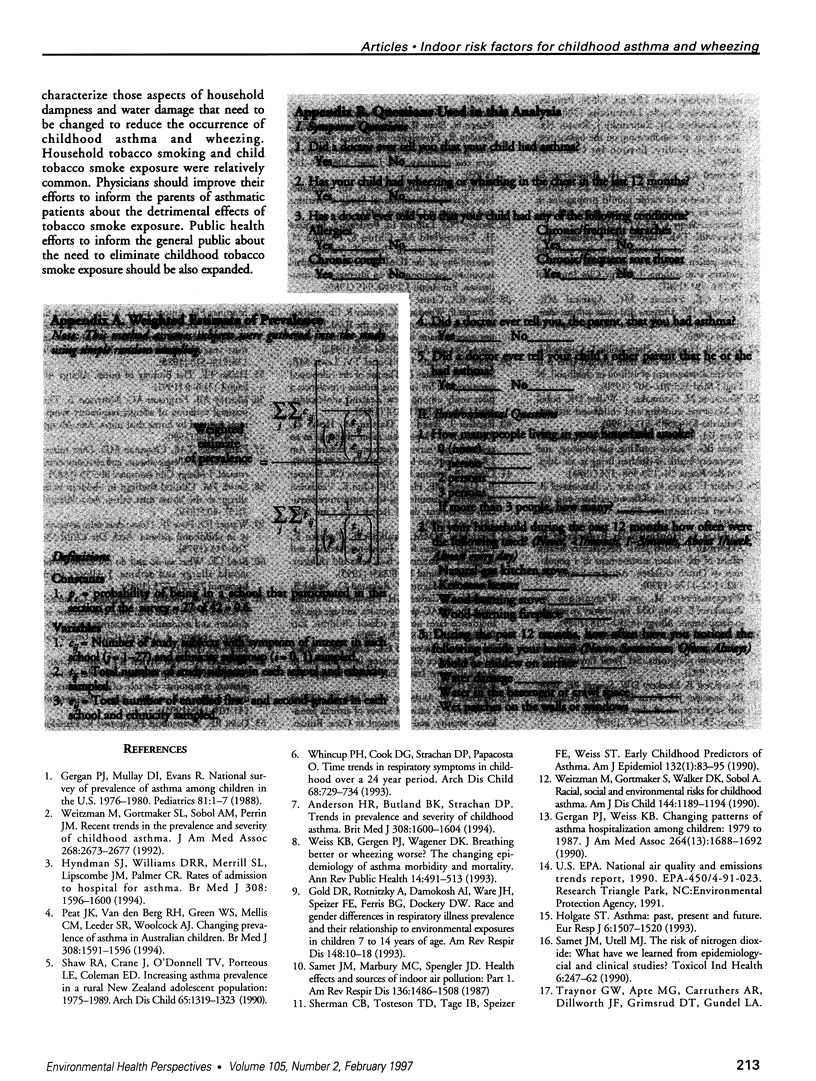
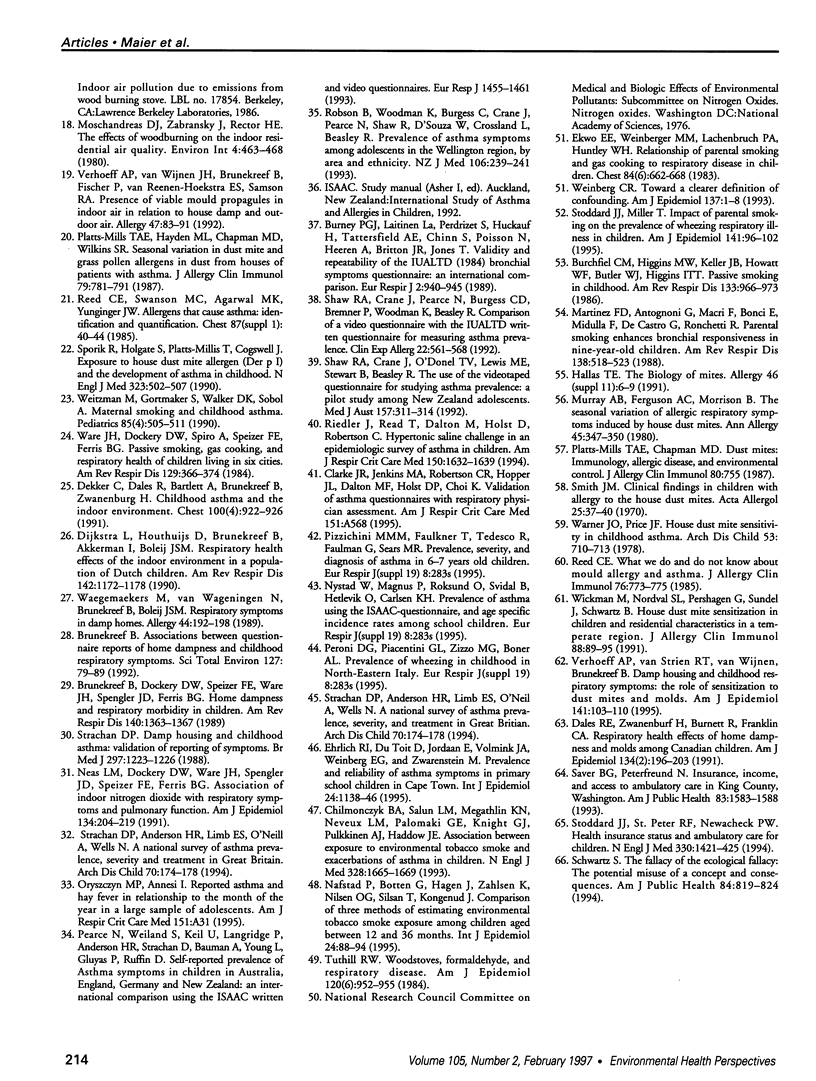
Selected References
These references are in PubMed. This may not be the complete list of references from this article.
- Anderson H. R., Butland B. K., Strachan D. P. Trends in prevalence and severity of childhood asthma. BMJ. 1994 Jun 18;308(6944):1600–1604. doi: 10.1136/bmj.308.6944.1600. [DOI] [PMC free article] [PubMed] [Google Scholar]
- Brunekreef B. Associations between questionnaire reports of home dampness and childhood respiratory symptoms. Sci Total Environ. 1992 Dec 15;127(1-2):79–89. doi: 10.1016/0048-9697(92)90471-4. [DOI] [PubMed] [Google Scholar]
- Brunekreef B., Dockery D. W., Speizer F. E., Ware J. H., Spengler J. D., Ferris B. G. Home dampness and respiratory morbidity in children. Am Rev Respir Dis. 1989 Nov;140(5):1363–1367. doi: 10.1164/ajrccm/140.5.1363. [DOI] [PubMed] [Google Scholar]
- Burchfiel C. M., Higgins M. W., Keller J. B., Howatt W. F., Butler W. J., Higgins I. T. Passive smoking in childhood. Respiratory conditions and pulmonary function in Tecumseh, Michigan. Am Rev Respir Dis. 1986 Jun;133(6):966–973. doi: 10.1164/arrd.1986.133.6.966. [DOI] [PubMed] [Google Scholar]
- Burney P. G., Laitinen L. A., Perdrizet S., Huckauf H., Tattersfield A. E., Chinn S., Poisson N., Heeren A., Britton J. R., Jones T. Validity and repeatability of the IUATLD (1984) Bronchial Symptoms Questionnaire: an international comparison. Eur Respir J. 1989 Nov;2(10):940–945. [PubMed] [Google Scholar]
- Chilmonczyk B. A., Salmun L. M., Megathlin K. N., Neveux L. M., Palomaki G. E., Knight G. J., Pulkkinen A. J., Haddow J. E. Association between exposure to environmental tobacco smoke and exacerbations of asthma in children. N Engl J Med. 1993 Jun 10;328(23):1665–1669. doi: 10.1056/NEJM199306103282303. [DOI] [PubMed] [Google Scholar]
- Dales R. E., Zwanenburg H., Burnett R., Franklin C. A. Respiratory health effects of home dampness and molds among Canadian children. Am J Epidemiol. 1991 Jul 15;134(2):196–203. doi: 10.1093/oxfordjournals.aje.a116072. [DOI] [PubMed] [Google Scholar]
- Dekker C., Dales R., Bartlett S., Brunekreef B., Zwanenburg H. Childhood asthma and the indoor environment. Chest. 1991 Oct;100(4):922–926. doi: 10.1378/chest.100.4.922. [DOI] [PubMed] [Google Scholar]
- Dijkstra L., Houthuijs D., Brunekreef B., Akkerman I., Boleij J. S. Respiratory health effects of the indoor environment in a population of Dutch children. Am Rev Respir Dis. 1990 Nov;142(5):1172–1178. doi: 10.1164/ajrccm/142.5.1172. [DOI] [PubMed] [Google Scholar]
- Ehrlich R. I., Du Toit D., Jordaan E., Volmink J. A., Weinberg E. G., Zwarenstein M. Prevalence and reliability of asthma symptoms in primary school children in Cape Town. Int J Epidemiol. 1995 Dec;24(6):1138–1145. doi: 10.1093/ije/24.6.1138. [DOI] [PubMed] [Google Scholar]
- Ekwo E. E., Weinberger M. M., Lachenbruch P. A., Huntley W. H. Relationship of parental smoking and gas cooking to respiratory disease in children. Chest. 1983 Dec;84(6):662–668. doi: 10.1378/chest.84.6.662. [DOI] [PubMed] [Google Scholar]
- Gergen P. J., Mullally D. I., Evans R., 3rd National survey of prevalence of asthma among children in the United States, 1976 to 1980. Pediatrics. 1988 Jan;81(1):1–7. [PubMed] [Google Scholar]
- Gergen P. J., Weiss K. B. Changing patterns of asthma hospitalization among children: 1979 to 1987. JAMA. 1990 Oct 3;264(13):1688–1692. [PubMed] [Google Scholar]
- Gold D. R., Rotnitzky A., Damokosh A. I., Ware J. H., Speizer F. E., Ferris B. G., Jr, Dockery D. W. Race and gender differences in respiratory illness prevalence and their relationship to environmental exposures in children 7 to 14 years of age. Am Rev Respir Dis. 1993 Jul;148(1):10–18. doi: 10.1164/ajrccm/148.1.10. [DOI] [PubMed] [Google Scholar]
- Hallas T. E. The biology of mites. Allergy. 1991;46 (Suppl 11):6–9. doi: 10.1111/j.1398-9995.1991.tb00641.x. [DOI] [PubMed] [Google Scholar]
- Holgate S. T. The 1992 Cournand Lecture. Asthma: past, present and future. Eur Respir J. 1993 Nov;6(10):1507–1520. [PubMed] [Google Scholar]
- Hyndman S. J., Williams D. R., Merrill S. L., Lipscombe J. M., Palmer C. R. Rates of admission to hospital for asthma. BMJ. 1994 Jun 18;308(6944):1596–1600. doi: 10.1136/bmj.308.6944.1596. [DOI] [PMC free article] [PubMed] [Google Scholar]
- Martinez F. D., Antognoni G., Macri F., Bonci E., Midulla F., De Castro G., Ronchetti R. Parental smoking enhances bronchial responsiveness in nine-year-old children. Am Rev Respir Dis. 1988 Sep;138(3):518–523. doi: 10.1164/ajrccm/138.3.518. [DOI] [PubMed] [Google Scholar]
- Murray A. B., Ferguson A. C., Morrison B. The seasonal variation of allergic respiratory symptoms induced by house dust mites. Ann Allergy. 1980 Dec;45(6):347–350. [PubMed] [Google Scholar]
- Nafstad P., Botten G., Hagen J. A., Zahlsen K., Nilsen O. G., Silsand T., Kongerud J. Comparison of three methods for estimating environmental tobacco smoke exposure among children aged between 12 and 36 months. Int J Epidemiol. 1995 Feb;24(1):88–94. doi: 10.1093/ije/24.1.88. [DOI] [PubMed] [Google Scholar]
- Neas L. M., Dockery D. W., Ware J. H., Spengler J. D., Speizer F. E., Ferris B. G., Jr Association of indoor nitrogen dioxide with respiratory symptoms and pulmonary function in children. Am J Epidemiol. 1991 Jul 15;134(2):204–219. doi: 10.1093/oxfordjournals.aje.a116073. [DOI] [PubMed] [Google Scholar]
- Peat J. K., van den Berg R. H., Green W. F., Mellis C. M., Leeder S. R., Woolcock A. J. Changing prevalence of asthma in Australian children. BMJ. 1994 Jun 18;308(6944):1591–1596. doi: 10.1136/bmj.308.6944.1591. [DOI] [PMC free article] [PubMed] [Google Scholar]
- Platts-Mills T. A., Chapman M. D. Dust mites: immunology, allergic disease, and environmental control. J Allergy Clin Immunol. 1987 Dec;80(6):755–775. doi: 10.1016/s0091-6749(87)80261-0. [DOI] [PubMed] [Google Scholar]
- Platts-Mills T. A., Hayden M. L., Chapman M. D., Wilkins S. R. Seasonal variation in dust mite and grass-pollen allergens in dust from the houses of patients with asthma. J Allergy Clin Immunol. 1987 May;79(5):781–791. doi: 10.1016/0091-6749(87)90211-9. [DOI] [PubMed] [Google Scholar]
- Reed C. E. What we do and do not know about mold allergy and asthma. J Allergy Clin Immunol. 1985 Dec;76(6):773–775. doi: 10.1016/0091-6749(85)90746-8. [DOI] [PubMed] [Google Scholar]
- Riedler J., Reade T., Dalton M., Holst D., Robertson C. Hypertonic saline challenge in an epidemiologic survey of asthma in children. Am J Respir Crit Care Med. 1994 Dec;150(6 Pt 1):1632–1639. doi: 10.1164/ajrccm.150.6.7952626. [DOI] [PubMed] [Google Scholar]
- Robson B., Woodman K., Burgess C., Crane J., Pearce N., Shaw R., D'Souza W., Crossland L., Beasley R. Prevalence of asthma symptoms among adolescents in the Wellington region, by area and ethnicity. N Z Med J. 1993 Jun 23;106(958):239–241. [PubMed] [Google Scholar]
- Samet J. M., Marbury M. C., Spengler J. D. Health effects and sources of indoor air pollution. Part I. Am Rev Respir Dis. 1987 Dec;136(6):1486–1508. doi: 10.1164/ajrccm/136.6.1486. [DOI] [PubMed] [Google Scholar]
- Samet J. M., Utell M. J. The risk of nitrogen dioxide: what have we learned from epidemiological and clinical studies? Toxicol Ind Health. 1990 Mar;6(2):247–262. [PubMed] [Google Scholar]
- Saver B. G., Peterfreund N. Insurance, income, and access to ambulatory care in King County, Washington. Am J Public Health. 1993 Nov;83(11):1583–1588. doi: 10.2105/ajph.83.11.1583. [DOI] [PMC free article] [PubMed] [Google Scholar]
- Schwartz S. The fallacy of the ecological fallacy: the potential misuse of a concept and the consequences. Am J Public Health. 1994 May;84(5):819–824. doi: 10.2105/ajph.84.5.819. [DOI] [PMC free article] [PubMed] [Google Scholar]
- Shaw R. A., Crane J., O'Donnell T. V., Lewis M. E., Stewart B., Beasley R. The use of a videotaped questionnaire for studying asthma prevalence. A pilot study among New Zealand adolescents. Med J Aust. 1992 Sep 7;157(5):311–314. [PubMed] [Google Scholar]
- Shaw R. A., Crane J., O'Donnell T. V., Porteous L. E., Coleman E. D. Increasing asthma prevalence in a rural New Zealand adolescent population: 1975-89. Arch Dis Child. 1990 Dec;65(12):1319–1323. doi: 10.1136/adc.65.12.1319. [DOI] [PMC free article] [PubMed] [Google Scholar]
- Shaw R. A., Crane J., Pearce N., Burgess C. D., Bremner P., Woodman K., Beasley R. Comparison of a video questionnaire with the IUATLD written questionnaire for measuring asthma prevalence. Clin Exp Allergy. 1992 May;22(5):561–568. doi: 10.1111/j.1365-2222.1992.tb00166.x. [DOI] [PubMed] [Google Scholar]
- Sherman C. B., Tosteson T. D., Tager I. B., Speizer F. E., Weiss S. T. Early childhood predictors of asthma. Am J Epidemiol. 1990 Jul;132(1):83–95. doi: 10.1093/oxfordjournals.aje.a115646. [DOI] [PubMed] [Google Scholar]
- Smith J. M. Clinical findings in children with allergy to the house dust mites. Acta Allergol. 1970 Apr;25(1):37–40. doi: 10.1111/j.1398-9995.1970.tb01378.x. [DOI] [PubMed] [Google Scholar]
- Sporik R., Holgate S. T., Platts-Mills T. A., Cogswell J. J. Exposure to house-dust mite allergen (Der p I) and the development of asthma in childhood. A prospective study. N Engl J Med. 1990 Aug 23;323(8):502–507. doi: 10.1056/NEJM199008233230802. [DOI] [PubMed] [Google Scholar]
- Stoddard J. J., Miller T. Impact of parental smoking on the prevalence of wheezing respiratory illness in children. Am J Epidemiol. 1995 Jan 15;141(2):96–102. doi: 10.1093/oxfordjournals.aje.a117418. [DOI] [PubMed] [Google Scholar]
- Stoddard J. J., St Peter R. F., Newacheck P. W. Health insurance status and ambulatory care for children. N Engl J Med. 1994 May 19;330(20):1421–1425. doi: 10.1056/NEJM199405193302006. [DOI] [PubMed] [Google Scholar]
- Strachan D. P., Anderson H. R., Limb E. S., O'Neill A., Wells N. A national survey of asthma prevalence, severity, and treatment in Great Britain. Arch Dis Child. 1994 Mar;70(3):174–178. doi: 10.1136/adc.70.3.174. [DOI] [PMC free article] [PubMed] [Google Scholar]
- Strachan D. P., Anderson H. R., Limb E. S., O'Neill A., Wells N. A national survey of asthma prevalence, severity, and treatment in Great Britain. Arch Dis Child. 1994 Mar;70(3):174–178. doi: 10.1136/adc.70.3.174. [DOI] [PMC free article] [PubMed] [Google Scholar]
- Strachan D. P. Damp housing and childhood asthma: validation of reporting of symptoms. BMJ. 1988 Nov 12;297(6658):1223–1226. doi: 10.1136/bmj.297.6658.1223. [DOI] [PMC free article] [PubMed] [Google Scholar]
- Tuthill R. W. Woodstoves, formaldehyde, and respiratory disease. Am J Epidemiol. 1984 Dec;120(6):952–955. doi: 10.1093/oxfordjournals.aje.a113966. [DOI] [PubMed] [Google Scholar]
- Verhoeff A. P., van Strien R. T., van Wijnen J. H., Brunekreef B. Damp housing and childhood respiratory symptoms: the role of sensitization to dust mites and molds. Am J Epidemiol. 1995 Jan 15;141(2):103–110. doi: 10.1093/oxfordjournals.aje.a117398. [DOI] [PubMed] [Google Scholar]
- Verhoeff A. P., van Wijnen J. H., Brunekreef B., Fischer P., van Reenen-Hoekstra E. S., Samson R. A. Presence of viable mould propagules in indoor air in relation to house damp and outdoor air. Allergy. 1992 Apr;47(2 Pt 1):83–91. doi: 10.1111/j.1398-9995.1992.tb05093.x. [DOI] [PubMed] [Google Scholar]
- Waegemaekers M., Van Wageningen N., Brunekreef B., Boleij J. S. Respiratory symptoms in damp homes. A pilot study. Allergy. 1989 Apr;44(3):192–198. doi: 10.1111/j.1398-9995.1989.tb02261.x. [DOI] [PubMed] [Google Scholar]
- Ware J. H., Dockery D. W., Spiro A., 3rd, Speizer F. E., Ferris B. G., Jr Passive smoking, gas cooking, and respiratory health of children living in six cities. Am Rev Respir Dis. 1984 Mar;129(3):366–374. doi: 10.1164/arrd.1984.129.3.366. [DOI] [PubMed] [Google Scholar]
- Warner J. O., Price J. F. House dust mite sensitivity in childhood asthma. Arch Dis Child. 1978 Sep;53(9):710–713. doi: 10.1136/adc.53.9.710. [DOI] [PMC free article] [PubMed] [Google Scholar]
- Weinberg C. R. Toward a clearer definition of confounding. Am J Epidemiol. 1993 Jan 1;137(1):1–8. doi: 10.1093/oxfordjournals.aje.a116591. [DOI] [PubMed] [Google Scholar]
- Weiss K. B., Gergen P. J., Wagener D. K. Breathing better or wheezing worse? The changing epidemiology of asthma morbidity and mortality. Annu Rev Public Health. 1993;14:491–513. doi: 10.1146/annurev.pu.14.050193.002423. [DOI] [PubMed] [Google Scholar]
- Weitzman M., Gortmaker S. L., Sobol A. M., Perrin J. M. Recent trends in the prevalence and severity of childhood asthma. JAMA. 1992 Nov 18;268(19):2673–2677. [PubMed] [Google Scholar]
- Weitzman M., Gortmaker S., Sobol A. Racial, social, and environmental risks for childhood asthma. Am J Dis Child. 1990 Nov;144(11):1189–1194. doi: 10.1001/archpedi.1990.02150350021016. [DOI] [PubMed] [Google Scholar]
- Weitzman M., Gortmaker S., Walker D. K., Sobol A. Maternal smoking and childhood asthma. Pediatrics. 1990 Apr;85(4):505–511. [PubMed] [Google Scholar]
- Whincup P. H., Cook D. G., Strachan D. P., Papacosta O. Time trends in respiratory symptoms in childhood over a 24 year period. Arch Dis Child. 1993 Jun;68(6):729–734. doi: 10.1136/adc.68.6.729. [DOI] [PMC free article] [PubMed] [Google Scholar]
- Wickman M., Nordvall S. L., Pershagen G., Sundell J., Schwartz B. House dust mite sensitization in children and residential characteristics in a temperate region. J Allergy Clin Immunol. 1991 Jul;88(1):89–95. doi: 10.1016/0091-6749(91)90305-8. [DOI] [PubMed] [Google Scholar]


